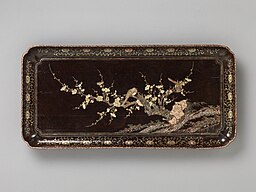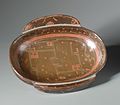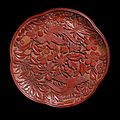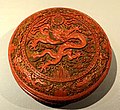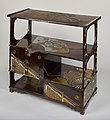Lacquerware

Lacquerware are objects decoratively covered with lacquer. Lacquerware includes small or large containers, tableware, a variety of small objects carried by people, and larger objects such as furniture and even coffins painted with lacquer. Before lacquering, the surface is sometimes painted with pictures, inlaid with shell and other materials, or carved. The lacquer can be dusted with gold or silver and given further decorative treatments.
East Asian countries have long traditions of lacquer work, going back several thousand years in the cases of China, Japan and Korea. The best known lacquer, an urushiol-based lacquer common in East Asia, is obtained from the dried sap of Toxicodendron vernicifluum. Other types of lacquers are processed from a variety of plants and insects. The traditions of lacquer work in Southeast Asia, South Asia and the Americas are also ancient and originated independently. True lacquer is not made outside Asia, but some imitations, such as Japanning in Europe, or parallel techniques, are often loosely referred to a "lacquer."
East Asia
[edit]The oldest lacquer tree found is from the Jōmon period in Japan, 12600 years ago.[1][2] The oldest lacquerware in the world, burial ornaments which were created in 9th millennium century B.C., were unearthed at the Kakinoshima site in Hakodate, Hokkaido, Japan.[3][4][5][2] Various prehistoric lacquerwares have been unearthed in China dating back to the Neolithic period and objects. The early known lacquerware was thought to be a red wooden bowl, which was unearthed at a Hemudu culture (c. 5th millennium BC) site in Zhejiang, China.[6][7][8]
Chinese lacquerware
[edit]This section needs expansion. You can help by adding to it. (January 2022) |




During the Shang dynasty (ca. 1600–1046 BC) of China, sophisticated lacquer process techniques developed became a highly artistic craft.[1]
During the Eastern Zhou period (771–256 BC), lacquerware began appearing in large quantity. This is the earliest era from which notable quantities of lacquerware have survived,[9] with states, later kingdoms, of Qin and Chu producing the largest number of lacquerware. The state of Chu having the geographical advantage and warmer climates enabled dedicated mass cultivation of lacquer trees and for lacquerware to become a commercial industry.[10] Because of this, Chu-state became famous for its lacquerware exports in the neighbouring states in the Zhou kingdom, with literary references found in books like Zhuangzi and Shangshu, and providing some cultural cross-pollination between the southern culture of Chu and the culture of Zhongyuan.[11][12]
At the time of the Han dynasty (206 BC – 220 AD), special administrations were established to organize and divide labor for the expanding lacquer production in China.[13] Elaborate incised decorations were used in lacquerware during the Han dynasty.[14]
In the Tang dynasty (618–907), Chinese lacquerware saw a new style marked by the use of sheets of gold or silver made in various shapes, such as birds, animals, and flowers.[13] The cut-outs were affixed onto the surface of the lacquerware, after which new layers of lacquer were applied, dried, and then ground away, so the surface could be polished to reveal the golden or silvery patterns beneath.[13] This was done by a technique known as pingtuo.[15] Such techniques were time-consuming and costly, but these lacquerware were considered highly refined.[13] It was also the period when the earliest practice of carving lacquerware began.[16]
The art of inlaid gold, silver, and mother-of-pearl continued from the Tang into the Song dynasty (960–1279).[17] Several existing decorative techniques gradually developed further after the 10th century, such as diaoqi (carved lacquer) which involves building up layers comprising thinly-applied coats of lacquer and carving it into a three-dimensional design; qiangjin (engraved gold) in which fine lines are incised, an adhesive of lacquer is applied, and gold foil or powder is pressed into the grooves; and diaotian or tianqi (filled-in) in which the lacquer is inlaid with lacquer of another color.[14] A variation of diaotian or tianqi is known as moxian (polish-reveal) in which a design is built up with lacquer in certain areas, the remaining areas are filled with lacquer of a different color, and the entire surface is polished down.[14] Especially the art of inlaying lacquer with mother-of-pearl was intensively developed during the Song dynasty.[14][17] However, during the Song, the artistic craft also made use of inlaid gold in a process of which is to engrave intricate patterns in the lacquer surface and to fill the intaglio with gold powder.[13]
The knowledge of the Chinese methods of the lacquer process spread from China during the Han, Tang and Song dynasties,[18] eventually it was introduced to Korea, Japan.[18] In Japan, the art of lacquerware-making came along with Buddhism and other cultural artifacts from China via the Korean Peninsula during the 8th century,[19] and carved lacquerware came to Japan from Ming dynasty China during the 14th century.[19] One of the earliest Japanese techniques for decorating the lacquer surface was, besides painting simple designs, the gold and silver foil inlay of the Nara period (710–784). This technique was transmitted from China during the Tang dynasty.[14]
Coromandel lacquer is a Chinese export type, so called because it was shipped to European markets via the Coromandel coast of India.
Gallery
[edit]-
Red lacquer wood bowl from the Chinese Hemudu culture dated to 4000–5000 BC, the oldest such piece ever found.
-
Coffin from the Tomb of Marquis Yi of Zeng
-
Lacquer dou-vessel from the Tomb of Marquis Yi of Zeng
-
Lacquerware box, Warring States period
-
Painted Lacquered Wood Mandarin Duck-shaped Case, Tomb of Marquis Yi of Zeng
-
Lacquered Shield, Tomb of Marquis Yi of Zeng
-
Lacquered yuren (羽人) figure on a toad stand, Chu kingdom, Warring States period.
-
Lacquer box in shape of pigs, Chu kingdom, Warring States.
-
Openwork lacquered screen with animal designs, Warring States period
-
Painted lacquer hu-jar with dragon-shaped handles, Warring States period
-
Lacquer box of phoenix pattern, Warring States.
-
Painted lacquer flat flask with coiled serpents, Warring States.
-
Lacquered winged goblet (zh:羽觞), also known as "eared" or flanged cup (耳杯) from Warring States.
-
Lacquered flanged cup with cloud designs from Warring States.
-
Lacquered winged cup from Warring States with geometric design.
-
Lacquer phoenix cup, state of Chu, Warring States.
-
"Eared" or flanged cup (耳杯), Qin or Han dynasty
-
Lacquered flask, Qin or Han dynasty
-
Pig-shaped lacquered case, Qin or Han dynasty
-
Han dynasty lacquerware unearthed at Mawangdui, 2nd century BC
-
Lacquerware box from Mawangdui, Han dynasty.
-
Lacquerware screen, Han dynasty
-
Lacquer dish, Han dynasty
-
Inkstone and lacquer case, Western Han dynasty
-
Lacquer dish with cloud-dragon design, Han dynasty
-
Lacquer Wine-Cup Container and wine cup set, Han dynasty
-
Western Han dynasty Lacquered flanged cup, known as winged goblet (zh:羽觞) or "eared cup"(耳杯) of Prince of Tianchang
-
Lacquered pottery flanged or eared cup, Han dynasty
-
Lacquered flanged cup, known as winged goblet (zh:羽觞), Han dynasty
-
Western Han dynasty lacquer bowl
-
Lacquer flanged cups and dishes from Mawangdui, Han dynasty
-
Lacquered table, Western Han dynasty
-
Lacquerware in the shape of a man's head, Western Han (202 BC – 9 AD), Yunnan Provincial Museum, Kunming
-
Lacquer dressing case painted with dragon pattern, Han dynasty
-
Lacquered case, Han dynasty
-
Lacquerware coffin of Mawangdui, Han dynasty
-
Second coffin of Mawangdui, Han dynasty
-
Third coffin of Mawangdui, Han dynasty
-
Lidded cosmetic box, Western Han dynasty, about 100 BC – 25 AD
-
Lacquerware pot from Mawangdui Tomb.
-
Lacquered cosmetic box, Han dynasty
-
Lacquerware screen of Prince of Nanyue (reconstruction), Han dynasty
-
Oval Lidded Cosmetic Box (Duoyuan He) with Scrolling Clouds, Animals, and Birds, Han dynasty
-
Lacquered chest from Mawangdui.
-
Lacquerware flanged drinking vessels and plates from the Mawangdui Tomb.
-
Chinese painted artwork on the lacquered basket of Lolang, a region of the Han dynasty.
-
Lacquered zun, Han dynasty
-
Painted lacquerware dish from the tomb of Zhu Ran (182–249 AD) in Anhui province, showing figures wearing Hanfu, Eastern Wu, Three Kingdoms period.
-
Painted lacquerware tray from the tomb of Zhu Ran, Three Kingdoms period.
-
Black lacquered clogs from the tomb of Zhu Ran.
-
Painted lacquerware dish from the tomb of Zhu Ran, Three Kingdoms period.
-
Lacquered mirror with bronze and silver inlays, Tang dynasty
-
Black lacquered mirror back with four phoenixes, Tang dynasty
-
Lacquer mirror box with inlays for a Mirror, Tang - Song dynasty
-
Bowl in shape of a flower blossom, Song dynasty
-
Cup with Sword-Pommel Pattern, Song dynasty
-
Box with Pommel Scroll design, Song dynasty
-
Lacquered Buddhist abbot, Song dynasty
-
Black lacquered plum-blossom-shaped cup, Song dynasty
-
Black lacquer on wood core with wickerwork panels, Song dynasty
-
Tablescreen with Calligraphy of Sima Guang's Family Instructions, Song dynasty
-
Pan in the Form of a Plum Blossom with Birds and Flowers, Late Song dynasty
-
Black lacquered box with painted figures, Late Song dynasty
-
A lacquered table of the Yuan dynasty, 14th century, with an inlaid mother-of-pearl decoration of a tree
-
Carved lacquer box with the "Sword-Pommel Pattern", Yuan dynasty (1279–1368)
-
Black lacquer box with pearl inlays, late Yuan to early Ming dynasty.
-
Lacquer Dish with garden scene, Early Ming dynasty
-
Box, Ming dynasty, Yongle era (1403–1424)
-
Lacquer Box with pommel scroll design, Ming dynasty
-
Octagonal food box with pommel scrolls, Ming dynasty
-
Carved lacquer stem cup with the "Sword-Pommel Pattern", mid-Ming dynasty
-
Lacquer box with dragon motifs and inlays, Ming dynasty
-
Covered box with dragon motif, Ming dynassty, Jiajing era, 1522-1566 AD
-
Carved red lacquer on wood core, Ming dynasty
-
Red Lacquer Wardrobes Inlaid with Various Treasures, Ming dynasty
-
Lacquer cabinet with dragon and cloud motifs, from Wanli era, Ming dynasty
-
Detail of lacquer cabinet with dragon and cloud motifs, Ming dynasty
-
Black lacquered medicine cabinet with dragon patterns from Wanli era, Ming dynasty.
-
Tray with dragons, Ming dynasty.
-
Lacquer table-screen
-
Late Ming - Early Qing dynasty lacquered Case
-
Square dish, Qing dynasty, Kangxi era (1662–1722)
-
Carved lacquer calabash-bottle, Qing dynasty
-
Lacquered Scripture Box, Qing dynasty
-
Coromandel lacquer folding screen with a courtly progress in lacquer, mother of pearl, tortoiseshell and gold, Qing dynasty, 1750–1800
-
Carved lacquer ruyi, Qing dynasty
-
Lacquer canopy bed, Qing dynasty
-
Lacquer canopy bed, Qing dynasty
-
Lacquer table and chairs, Qing dynasty
-
Lacquered armor of the Dali Kingdom
-
Qing dynasty Lacquered Box
-
Woven Bamboo Lacquer Fruit Case, Qing dynasty
-
Qing dynasty Lacquered Box
-
Qing dynasty carved lacquer snuff bottle.
-
Carved lacquer chair, Qing dynasty
-
Lacquerware set by the Yi people.
Korean lacquerware
[edit]The very term 'Najeonchilgi' is a combination of two particular words: 'najeon'– mother-of-pearl and ‘chilgi’ which refers to lacquerware. ‘najeon’ refers to the composite material which forms the inner shiny shell layer. The Three Kingdom period (57 B.C. – 668 A.D.) witnessed the introduction of the first method and the second one was introduced during the Shilla period (668 A.D. – 935 A.D.). The Goryeo dynasty (918–1392), considered the golden period of this craft, was influenced by Buddhism.
Japanese lacquerware
[edit]
The term for lacquer is urushi (漆), source of the English hybrid word "urushiol". Etymologically, urushi may be related to the words uruwashii ("beautiful") or uruoi ("watered", "profitable", "favored"), due speculatively to their value or shiny appearance, or perhaps the humidifying rooms used in production of lacquered wares. The term "Japanning" in the 17th century is a term for the technique used by Europe to emulate Asian lacquer, derived from the then famous Japanese lacquer.
The general characteristic of Japanese lacquerware is the widespread use of various Maki-e techniques compared to other countries. As a result, there are many works in which relatively vivid gold and silver patterns and pictures shine on the black base of lacquerware, and the entire lacquerware is covered with shiny gold and silver grains.[20]
History and regional production
[edit]Primitive lacquer was used in Japan as early as 12,600 BC, during the Jōmon period.[2]
Lacquer was used in Japan as early as 7000 BCE, during the Jōmon period. Evidence for the earliest lacquerware was discovered at the Kakinoshima "B" Excavation Site in Hokkaido.[21] These objects were discovered in a pit grave dating from the first half of the Initial Jōmon period (approx. 9,000 years ago)[2][4][5] Japanese lacquering technology may have been invented by the Jōmon. They learned to refine urushi (poison oak sap) – the process taking several months. Iron oxide (colcothar) and cinnabar (mercury sulfide) were used for producing red lacquer.[22] Lacquer was used both on pottery, and on different types of wooden items. In some cases, burial clothes for the dead were also lacquered.[22] Many lacquered objects have turned up during the Early Jōmon period; this indicates that this was an established part of Jōmon culture.[22] Experts are divided on whether Jōmon lacquer was derived from Chinese techniques, or invented independently. For example, Mark Hudson believes that “Jomon lacquer technology was developed independently in Japan rather than being introduced from China as once believed”.[23][22]
During the Asuka and Nara periods, between the 7th and 8th centuries, Chinese lacquer art forms were imported to Japan.

In the Heian period (794-1185), various Maki-e techniques characteristic of Japanese lacquerware were developed. While the method of drawing designs with a brush by dissolving gold powder in lacquer is a common technique in other countries, the method of drawing designs with lacquer and then sprinkling gold, silver, or copper powder of various sizes and shapes on top to polish them was developed in Japan. This made it possible to make the gold and silver of lacquerware brighter than before.[20]
In the Kamakura period (1185–1333), carved lacquer from the Song dynasty of China was imported to Japan. However, many Japanese lacquer craftsmen did not adopt the Chinese method of depositing lacquer and then carving it; instead, they created Kamakurabori, a method of carving wood and then coating lacquer.[24]
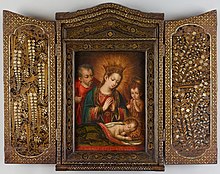
Japanese lacquerware was abundantly exported to China where the Ming and Qing rulers generally described Japanese lacquerwares as " foreign lacquer " ( yangqi ). Yang Ming, and famous lacquer man Zhejiang, made annotations for A Record of Decoration with Lacquer, ... People of the Ming dynasty once recorded: “The decoration art with lacquer coated with gold originated (maki-e) from Japan". Yang in the reign of Xuande of the Ming dynasty made a trip to Japan to study Japanese techniques, and a Japanese visited a Chinese imperial workshop in Beijing during the Ming dynasty. It is well documented that the Yongzheng Emperor had a formidable interest in Japanese lacquer, yangqi, and this was reflected in many of the works produced in the Imperial workshops during his reign.[25][26][27][28][29] In the Azuchi-Momoyama period (1568-1600) also made its way into Colonial Mexico (Manila Galleons) and Europe by Nanban trade. Japanese lacquerware attracted European aristocrats and missionaries from Europe, and western style chests and church furniture were exported in response to their requests.[30][31][32]

The Edo period (1603–1868) saw an increase in the focused cultivation of lacquer trees and the development of the techniques used. In the 18th century colored lacquers came into wider use. With the development of economy and culture, the artistic quality of lacquered furniture has improved. Hon'ami Kōetsu and Ogata Kōrin brought the designs of the Rinpa school of painting into lacquerware. From the middle of the Edo period, inro became popular as men's accessories, and wealthy merchants of the chōnin class and samurai class collected inro of high aesthetic value, precisely designed with lacquer.[33][34] Marie Antoinette and Maria Theresa are known collectors of Japanese lacquerware and their collections are now often exhibited in the Louvre and the Palace of Versailles.[20]
In the Meiji period (1868-1912), Richly-decorated lacquerwares in original designs were popular domestically, and even more so with Western buyers during this period of European and American fascination with Japanese art. Shibata Zeshin's lacquer work was especially popular.[35] In addition, lacquerware called Shibayama, which was created in the Edo period, became popular for its showy style, inlaid with gold, silver, shellfish, ivory, coral, tortoise shell and ceramics, and reached its peak during this period. Lacquerware called Somada, which was created in the Edo period and characterized by regular patterns of finely cut seashells, gold leaf and silver leaf, also became popular during this period.[36] The government took an active interest in the art export market, promoting Japan's lacquers and other decorative arts at a succession of world's fairs.[37][38] Lacquer from Japanese workshops was recognised as technically superior to what could be produced anywhere else in the world.[39]
Today, the Japanese government has designated excellent lacquer artists as Living National Treasures and is encouraging them to make lacquerware. Lacquerware is produced throughout the Japanese archipelago, with many regional techniques and variations. Besides the very old Kamakura tradition mentioned above (and still alive today), the port town of Wajima provides a good example of regional lacquerware. Wajima-nuri, dating back to the 16th century, is characterized by use of the elm-like Japanese zelkova (keyaki 欅), powdered earth, and delicate features formed from cloth. (See the Japanese article, 輪島塗. A more complete list of regional lacquer traditions is available in the Japanese article.)
-
Tiered Stand with Designs Alluding to The Tale of Genji, by Hon'ami Kōetsu, 17th century
-
Reading Stand with Mount Yoshino, Edo period, 18th century
-
Lacquered exterior of wakizashi Fusamune, Edo period, 18th century
-
Maki-e Writing-table, by Shirayama Shosai, Meiji period, 19th century, Khalili Collection of Japanese Art
-
by Living National Treasure Gonroku Matsuda, Showa period, 1960
Ryukyuan lacquerware
[edit]
Ryukyuan lacquerware is one of the chief artistic products of the Ryukyu Islands (today Okinawa Prefecture of Japan); it is quite distinct from the lacquerware found among the surrounding cultures. Nevertheless, Chinese and Japanese influences are present.
Southeast Asia
[edit]Burmese lacquerware
[edit]
Yun-de is lacquerware in Burmese, and the art is called Pan yun (ပန်းယွန်း). The lacquer is the sap tapped from the varnish tree or Thitsee (Gluta usitata, syn. Melanorrhoea usitata) that grows wild in the forests of Myanmar (formerly Burma).[40] It is straw-colored but turns black on exposure to air. When brushed in or coated on, it forms a hard glossy smooth surface resistant to a degree from the effects of exposure to moisture or heat.
History
[edit]The earliest fragments of lacquerware basketry found in Bagan dates back to the 13th century. Evidence for older lacquerware in Bagan remains inconclusive.[41]
Bayinnaung's conquest and subjugation in 1555–1562 of Manipur, Bhamo, Zinme (Chiang Mai), Linzin (Lan Xang), and up the Taping and Shweli rivers in the direction of Yunnan brought back large numbers of skilled craftsmen into Burma. It is thought that the finer sort of Burmese lacquerware, called Yun, was introduced during this period by imported artisans belonging to the Yun or Northern Thai people of the Chiang Mai region.[42]
Manufacture and design
[edit]
Lacquer vessels, boxes and trays have a coiled or woven bamboo-strip base often mixed with horsehair. The thitsee may be mixed with ashes or sawdust to form a putty-like substance called thayo which can be sculpted. The object is coated layer upon layer with thitsee and thayo to make a smooth surface, polished and engraved with intricate designs, commonly using red, green and yellow colors on a red or black background. Shwezawa is a distinctive form in its use of gold leaf to fill in the designs on a black background.[43][44]
Palace scenes, scenes from the Jataka tales, and the signs of the Burmese Zodiac are popular designs and some vessels may be encrusted with glass mosaic or semi-precious stones in gold relief.[44] The objects are all handmade and the designs and engraving done free-hand. It may take three to four months to finish a small vessel but perhaps over a year for a larger piece. The finished product is a result of teamwork and not crafted by a single person.[43]
Forms
[edit]The most distinctive vessel is probably a rice bowl on a stem with a spired lid for monks called hsun ok. Lahpet ok is a shallow dish with a lid and has a number of compartments for serving lahpet (pickled tea) with its various accompaniments. Stackable tiffin carriers fastened with a single handle or hsun gyaink are usually plain red or black. Daunglan are low tables for meals and may be simple broad based or have three curved feet in animal or floral designs with a lid. Water carafes or yeidagaung with a cup doubling as a lid, and vases are also among lacquerware still in use in many monasteries.[43][44]
Various round boxes with lids, small and large, are known as yun-it including ones for paan called kun-it (Burmese: ကွမ်းအစ်; betel boxes). Yun titta are rectangular boxes for storing various articles including peisa or palm leaf manuscripts when they are called sadaik titta. Pedestal dishes or small trays with a stem with or without a lid are known as kalat for serving delicacies or offering flowers to royalty or the Buddha. Theatrical troupes and musicians have their lacquerware in costumes, masks, head-dresses, and musical instruments, some of them stored and carried in lacquer trunks.[44] Boxes in the shape of a pumpkin or a bird such as the owl, which is believed to bring luck, or the hintha (Brahminy duck) are common too. Screens and small polygonal tables are also made for the tourist trade today.
Industry
[edit]Bagan is the major centre for the lacquerware industry where the handicraft has been established for nearly two centuries, and still practiced in the traditional manner. Here a government school of lacquerware was founded in the 1920s. Since plastics, porcelain and metal have superseded lacquer in most everyday utensils, it is today manufactured in large workshops mainly for tourists who come to see the ancient temples of Bagan. At the village of Kyaukka near Monywa in the Chindwin valley, however, sturdy lacquer utensils are still produced for everyday use mainly in plain black.[43]
A decline in the number of visitors combined with the cost of resin, which has seen a 40-fold rise in 15 years, has led to the closure of over two-thirds of more than 200 lacquerware workshops in Bagan.[45]
Vietnamese lacquer painting and lacquerware
[edit]


Sơn mài is a painting technique in Vietnam. It developed from the painters of the Hanoi EBAI in the 1930s and today is counted a national painting style with many famous painters.
In 1924 the Ecole des Beaux Arts was established in Hanoi. This institution was to be the birthplace of the revitalised art of lacquer painting. In 1934 the school opened its lacquer department and it was from here that well known contributors to the art including; Bui Trang Chuoc, Nguyen Van Binh, Nguyen Khang, Nguyen Duc Nung, Nguyen Tien Chung, and Pham Van Don would emerge.
It was the first generation of Vietnamese students of the Indochina School of Fine Art during the 1930s, who elevated the craft of lacquer painting to a truly fine art. Less interested in decor than their craftsmen predecessors, it was also these men who would begin a series of artistic innovations from which craftsmen producing purely utilitarian or decorative pieces would also benefit.
Creating images with crushed eggshell, painting pigment over gold and tin foil and adding sand to lacquer were all techniques developed by those first students. The metallic color lacquerware for which Vietnamese craftsmen are rightly famous, was first developed by artists experimenting with many innovative techniques.
After the reunification, the art of lacquerware was slowly dying out in Vietnam. But since the 1980s, the government has recognized it as a vital cultural and economic force and has encouraged the business community to invest in the craft. As a result, we see a resurgence of lacquerware and a proliferation of lacquerware products from Vietnam.
South Asia
[edit]
In India, the insect lac or shellac was used since ancient times. Shellac is the secretion of the lac bug (Tachardia lacca Kerr. or Laccifer lacca). It is used for wood finish, lacquerware, skin cosmetic, ornaments, dye for textiles, production of different grades of shellac for surface coating.[46] The Atharvaveda text 1200 BCE – 1000 BCE devotes a chapter to 'lākshā' and its various uses.[47]
Americas
[edit]Barniz de Pasto technique
[edit]Barniz de Pasto (es) is a lacquer-like varnish technique originating in the Pre-Columbian era that is a specialty of Pasto, Colombia. It is made by chewing the resin of the Andean mopa-mopa shrub (Elaeagia pastoensis) into thin layers, and then painting it and applying it to a wood, metal, clay or glass surface using heated stones.[48][49] Historically, the technique was applied to wooden keros, drinking vessels.
Mexican lacquerware
[edit]
Known in Mexican Spanish as laca or maque (from Japanese maki-e[50][self-published source]), Mexican lacquer has independent origins from Asian lacquer. In the pre-Hispanic period, a substance from the larvae of aje scale insects and/or oil from the chia seed were mixed with powdered minerals to create protective coatings and decorative designs. During this period, the process was almost always applied to dried gourds, especially to make the cups that Mesoamerican nobility drank chocolate from.
After the Conquest, the Spanish had indigenous craftsmen apply the technique to European style furniture and other items, changing the decorative motifs and color schemes, but the process and materials remained mostly the same. Asian lacquerware and artisans brought by the Nao de China also had an influence on the style and motifs of colonial Mexican lacquerware. Today, workshops creating lacquerware are limited to Olinalá, Temalacatzingo and Acapetlahuaya in the state of Guerrero, Uruapan and Pátzcuaro in Michoacán and Chiapa de Corzo in Chiapas. The most popular modern lacquerware are small boxes, sometimes known as cajitas de Olinalá.
See also
[edit]References
[edit]- ^ a b Webb, Marianne (2000). Lacquer: Technology and conservation. Oxford: Butterworth-Heinemann. p. 3. ISBN 978-0-7506-4412-9.
- ^ a b c d 1万2千年前のウルシ木片 世界最古、福井で出土, The Nikkei, November 6, 2011
- ^ Gary W. Crawford (October 2011). "Advances in Understanding Early Agriculture in Japan". Current Anthropology. 52 (S4). The University of Chicago Press: S334. doi:10.1086/658369. JSTOR 10.1086/658369. S2CID 143756517. Retrieved 30 November 2020.
- ^ a b "Kakinoshima Jomon Archaeological Site". Hokkaido Prefectural Government, Hokkaido Tourism Organization. Archived from the original on 7 July 2020. Retrieved 13 November 2022.
- ^ a b Kakinoshima Excavation Site Hokkaido Government
- ^ Fung, Christopher (1994). "The Beginnings of Settled Life". China: Ancient Culture, Modern Land. Norman: University of Oklahoma Press. p. 52. ISBN 9780806126838.
- ^ Li, Li (2011). China's Cultural Relics (3rd ed.). Cambridge: Cambridge University Press. pp. 139–140. ISBN 9780521186568.
- ^ Bagley, Robert (1999). "Shang Archaeology". The Cambridge History of Ancient China: From the Origins of Civilization to 221 B.C. Cambridge: Cambridge University Press. p. 178. ISBN 9780521470308.
- ^ Kleiner, Fred S. (January 2012). Gardner's Art Through The Ages: A Global History (14th ed.). Boston: Wadsworth, Cengage Learning. p. 995. ISBN 9780840030597.
- ^ 倪仁杰; 汤云叶 (October 2011). "浅述战国楚地漆器工业造型艺术". 工业设计.
- ^ 杜妍洁 (May 2019). "基于楚式髹漆工艺的现代文化创意产品设计研究". 美与时代 (796): 97.
- ^ 桂俊荣 (2011). 楚漆器文化艺术特质研究. Beijing: 中国社会科学出版社. ISBN 978-7516104675.
- ^ a b c d e Hang, Jian; Guo, Qiuhui (2006). Chinese arts & crafts. Translated by Zhu, Youruo; Song, Peiming. Beijing: China Intercontinental Press. pp. 54–58. ISBN 978-7-5085-0963-1.
- ^ a b c d e "Lacquerware of East Asia". The Metropolitan Museum of Art. Retrieved 21 September 2011.
- ^ Watt, James C. Y.; Ford, Barbara Brennan (1991). East Asian lacquer: the Florence and Herbert Irving Collection. New York: Metropolitan Museum of Art. pp. 20–21. ISBN 9780870996221.
- ^ Webb, Marianne (2000). Lacquer: Technology and Conservation. Oxford: Butterworth-Heinemann. p. 42. ISBN 9780750644129.
- ^ a b Watt, James C. Y.; Ford, Barbara Brennan (1991). East Asian lacquer: the Florence and Herbert Irving Collection. New York: Metropolitan Museum of Art. p. 23. ISBN 9780870996221.
- ^ a b Institute of the History of Natural Sciences and Chinese Academy of Sciences, ed. (1983). Ancient China's technology and science. Beijing: Foreign Languages Press. p. 211. ISBN 978-0-8351-1001-3.
- ^ a b Akio Haino. "Chinese Carved Lacquerware". Kyoto National Museum. Retrieved 2007-08-16.
- ^ a b c Masayuki Murata. 明治工芸入門 p.24. Me no Me, 2017 ISBN 978-4907211110
- ^ Hokkaido's Minamikayabe Town, Kakinoshima site B (北海道の南茅部町の垣ノ島B遺跡)
- ^ a b c d Jomon crafts and what they were for heritageofjapan.wordpress.com
- ^ Sannai Maruyama: A New View of Prehistoric Japan, Mark Hudson, Asia-Pacific Magazine, No. 2 May 1996 pp. 47-48.
- ^ Carved lacquer and Lacquered sculpture Kanagawa Prefectural Museum of Cultural History
- ^ "AN IMPERIAL GOLD-LACQUERED INCENSE STAND". www.christies.com. Retrieved 2021-01-19.
- ^ Kleutghen, Kristina (2017). "Imports and Imitations: The Taste for Japanese Lacquer in Eighteenth-Century China and France". Journal for Early Modern Cultural Studies. 17 (2): 175–206. doi:10.1353/jem.2017.0013. ISSN 1531-0485. OCLC 7308043513. S2CID 165251830.
- ^ Bayerova, Tatjana. (2015). Investigation and Conservation of East Asian Cabinets in Imperial Residences (1700-1900): Lacquerware & Porcelain. Conference 2013 Postprints. Griesser-Stermschegg, Martina., Trummer, Manfred., Schreiner, Manfred., Iby, Elfriede., Krist, Gabriela. Köln/Wien: Böhlau Verlag. ISBN 978-3-205-20192-2. OCLC 960757571.
- ^ Victoria and Albert Museum. (1998). The Victoria and Albert Museum: a bibliography and exhibition chronology, 1852-1996. James, Elizabeth, 1957-. London: Routledge. ISBN 978-1-315-07424-5. OCLC 900484109.
- ^ THIRTY GREAT INVENTIONS OF CHINA from millet agriculture to artemisinin. [S.l.]: SPRINGER VERLAG, SINGAPOR. 2020. ISBN 978-981-15-6525-0. OCLC 1227059965.
- ^ Moreno, Pilar Cabañas (January 2013). "Traces of Japanese art in New Spain: screens, "enconchados" and maques". Kawamura, Yayoi (Ed.), Namban Lacquer Remained in Spain. 400 Years After the. Keichô Embassy, Madrid, Ministerio de Cultura y Deporte y Japan Foundation, Pp. 85-106, Cd Versión.
- ^ "Namban & Enconchado: Japan and Mexico Meet". japan-and-mexico-meet.tumblr.com. Archived from the original on 2021-04-16. Retrieved 2021-01-19.
- ^ Urushi once attracted the world urushi-joboji.com
- ^ Masayuki Murata. 明治工芸入門 p.104. Me no Me, 2017 ISBN 978-4907211110
- ^ Yūji Yamashita. 明治の細密工芸 p.80. Heibonsha, 2014 ISBN 978-4582922172
- ^ Earle 1999, pp. 186–187.
- ^ Yūji Yamashita. 明治の細密工芸 pp.60-61. Heibonsha, 2014 ISBN 978-4582922172
- ^ Earle 1999, pp. 30–31.
- ^ Liddell, C. B. (2013-12-14). "[Review:] Japonisme and the Rise of the Modern Art Movement: The Arts of the Meiji Period". The Japan Times. Retrieved 2020-03-19.
- ^ Earle 1999, p. 187.
- ^ "Melanorrhoea usitatissima". die.net online dictionary. Retrieved 2007-03-31.
- ^ Berengueres (2007). "Ancient History and Tradition of Bagan Lacquerware".
- ^ D.G.E. Hall (1960). Burma. Hutchinson University Library. p. 42.[permanent dead link]
- ^ a b c d Blurton, Richard (2002). "A Path to Burmese Culture: The Art of Lacquer". The British Museum/Fathom. Archived from the original on 2007-04-04. Retrieved 2007-03-31.
- ^ a b c d "Burmese Lacquerware Collection". Art Only. 2006. Archived from the original on September 30, 2007. Retrieved 2007-03-31.
- ^ Kyi Wai. "Burmese Lacquerware Loses Its Shine". The Irrawaddy, January 19, 2009. Archived from the original on August 11, 2010. Retrieved 2009-03-19.
- ^ Green, C. L. (1995). "5: Insect Dyes". Non-Wood Forest Products 4: Natural colourants and dyestuffs. Rome: Food and Agriculture Organization of the United Nations. Archived from the original on 12 August 2011. Retrieved 3 July 2014.
- ^ Elements of Entomology (2007), Page 492, Dr. Rajendra Singh. Rastogi Publications.
- ^ "Crafts of Pasto". Spanish in Colombia. MinCultura. Retrieved 27 February 2017.
- ^ Brown, Michael A.; Frick, Julie Wilson (18 May 2012). "Exhibit Explores Prized Functional Items in Spanish America". Denver Art Museum. Retrieved 22 July 2014.
- ^ Roberts, Edward A. (2014). A Comprehensive Etymological Dictionary of the Spanish Language with Families of Words based on Indo-European Roots. Xlibris Corporation. p. 170. ISBN 9781493191130. Retrieved 19 May 2017.
Further reading
[edit]- East Asian lacquer: the Florence and Herbert Irving collection. New York: The Metropolitan Museum of Art. 1991.
- Japanese Lacquer, 1600–1900: selections from the Charles A. Greenfield collection. New York: The Metropolitan Museum of Art. 1980.
- Kawai, K.; Nakagawa, M.; Kawai, K.; Miyakoshi, T.; Miyashita, K.; Asami, T. (1992). "Heat treatment of Japanese lacquerware renders it hypoallergenic". Contact Dermatitis. 27 (4): 244–9. doi:10.1111/j.1600-0536.1992.tb03254.x. PMID 1451490. S2CID 12497249.
- Kawai, K.; Nakagawa, M.; Kawai, K.; Liew, F. M.; Yasuno, H. (1991). "Hyposensitization to urushiol among Japanese lacquer craftsmen: results of patch tests on students learning the art of lacquerware". Contact Dermatitis. 25 (5): 290–5. doi:10.1111/j.1600-0536.1991.tb01876.x. PMID 1839723. S2CID 9841818.
- Earle, Joe (1999). Splendors of Meiji: treasures of imperial Japan: masterpieces from the Khalili Collection. St. Petersburg, Fla.: Broughton International Inc. ISBN 1874780137. OCLC 42476594.
External links
[edit]- "Lacquerware Stories" Archived 2017-12-22 at the Wayback Machine at the Kyoto National Museum.
- Museum of Lacquer Art Münster Museum für Lackkunst in Germany
- The Craft and Care of East Asian Lacquer by Denver Art Museum
- Bone, Flesh, Skin: the making of Japanese Lacquer YouTube video by Getty Museum
- Intro to Urushi YouTube video by Dr.Kenji Toki at FabLabKamakura
- Lacquerware of East Asia essay at the MET Museum






